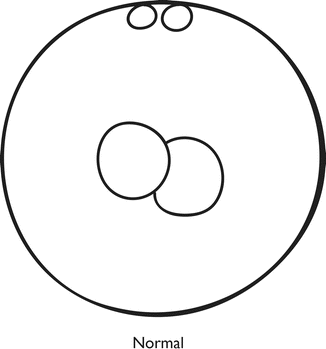and Paula Briggs2
(1)
Department of Obstetrics and Gynaecology, Monash University, Clayton, Victoria, Australia
(2)
Sexual and Reproductive Health, Southport and Ormskirk Hospital, Southport, UK
With the joining of the oocyte and the sperm an embryo is created (Fig. 2.1). As both the oocyte and the sperm (gametes) contribute 23 chromosomes (haploid), the embryo now is made up of 23 pairs of chromosomes (46). The developing embryo inherits half its genetic material from each of its parents, thus it is diploid, and its genetic makeup is determined for life. As the cells continue to divide rapidly, each nucleus contains an identical chromosomal template. By the time it reaches the uterine cavity, the embryo has developed to the blastocyst stage (Fig. 2.2). The blastocyst differentiates into outer cells, the trophoectoderm or trophoblast, which will form the placenta as it combines with the uterine endometrium, and inner cells which form the inner cell mass (Fig. 2.3). These will form the embryo, as well as the amnion and yolk sac. This is the stage at which the process of implantation commences. By the eighth day, the cells of the inner cell mass proliferate into a rounded bilaminar structure. The embryo will develop from, this and a small slit like space forms to become the amniotic cavity. The ectoderm develops from the floor of this cavity and makes up one of the layers of the bilaminar embryonic disc, the other layer being the endoderm. The mesoderm develops as a further layer between the ectoderm and endoderm. As it grows outwards, in combination with the trophoblast, the chorion is formed. The cells continuous with the endoderm extend along the inner aspect of the blastocyst producing another fluid filled sac – the primary yolk sac. Ultimately the ectoderm will form the skin, nervous system and parts of the eyes, ears and nose. The endoderm is the origin of the linings of the gut and respiratory system, whereas the mesoderm is the origin of muscle, bone, blood tissues and connective tissue.




